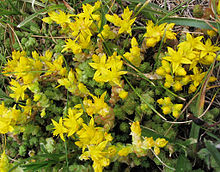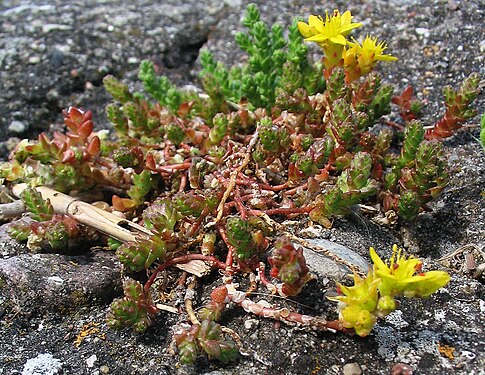Difference between revisions of "Sedum acre"
(New page: __NOTOC__{{Plantbox | name = ''LATINNAME'' <!--- replace LATINNAME with the actual latin name --> | common_names = <!--- if multiple, list all, if none, leave blank --> | growth_habi...) |
|||
| (One intermediate revision by one other user not shown) | |||
| Line 1: | Line 1: | ||
| − | + | {{SPlantbox | |
| − | | | + | |familia=Crassulaceae |
| − | | | + | |genus=Sedum |
| − | | | + | |species=acre |
| − | | | + | |common_name=Goldmoss Stonecrop, Goldmoss Sedum, Biting Stonecrop, Wallpepper |
| − | | | + | |name_ref=Wikipedia |
| − | | | + | |habit=cacti-succulent |
| − | | | + | |habit_ref=Flora - A Gardener's Encyclopedia |
| − | | | + | |Min ht box=2 |
| − | | | + | |Min ht metric=in |
| − | | | + | |Max ht box=4 |
| − | | | + | |Max ht metric=in |
| − | | | + | |height_ref=Flora - A Gardener's Encyclopedia |
| − | | | + | |Min wd box=12 |
| − | | | + | |Min wd metric=in |
| − | | | + | |Max wd box=24 |
| − | | | + | |Max wd metric=in |
| − | | | + | |width_ref=Flora - A Gardener's Encyclopedia |
| − | | | + | |lifespan=perennial |
| − | | | + | |life_ref=Flora - A Gardener's Encyclopedia |
| − | | | + | |exposure=sun |
| − | | | + | |sun_ref=Flora - A Gardener's Encyclopedia |
| − | | | + | |water=moderate, dry |
| − | | | + | |water_ref=Sunset National Garden Book |
| − | | | + | |features=flowers, ground cover |
| − | | | + | |flower_season=early summer, mid summer, late summer |
| − | | | + | |flower_ref=Flora - A Gardener's Encyclopedia |
| − | | | + | |flowers=orange, yellow |
| − | | | + | |Temp Metric=°F |
| + | |min_zone=5 | ||
| + | |usda_ref=Flora - A Gardener's Encyclopedia | ||
| + | |max_zone=10 | ||
| + | |image=Scharfer Mauerpfeffer Sedum acre 1.jpg | ||
| + | |image_width=220 | ||
}} | }} | ||
| + | '''''Sedum acre''''', the '''Goldmoss Stonecrop''', '''Goldmoss Sedum''', '''Biting Stonecrop''' or '''Wallpepper''', is a perennial [[plant]] native to [[Europe]], but also naturalised in [[North America]]. This plant grows as a creeping [[ground cover]], often in dry sandy [[soil]], but also in the cracks of [[masonry]]. It grows well in poor soils, sand, rock gardens, and rich dirt, in a variety of light conditions. It does not thrive in dense shade with limited water. | ||
| + | |||
| + | The leaves are simple, smooth-margined, and [[succulent]]. The flowers are yellow, Spring-blooming, in sprays held above the foliage. It spreads when allowed to do so, but is easily removed as it has shallow roots. It is used in [[hanging basket]]s and [[container garden]]s as a [[trailing accent]], [[border]]s, or groundcover. | ||
| + | |||
{{Inc| | {{Inc| | ||
| − | |||
Sedum acre, Linn. (S. neglectum, Ten.). Stonecrop. Wall Pepper. Love Entangle. Fig. 3583. Perennial, glabrous, cespitose: barren sts. creeping, branched, about 2 in. long; fl.-sts. 2-3 in. high: lvs. minute, about 1/4 in. long, fleshy, ovate, crowded, gibbous at base, sessile: fls. yellow, about 1/2 in. across, in 1-sided cymes, which have 2-5 forks; sepals lf.-like; petals lanceolate. Eu., N. Afr., E. Asia, and naturalized in N. Amer. Gn. 27, p. 316.—This is the commonest native species in England and one of the commonest in cult. Thrives best in poor soil and is a good ledge-plant and is frequently used for covering rather arid spots which would otherwise be bare. The lvs. have an acrid taste. Var. album, Hort., is a white-fld. form. Var. aureum, Mast., has the lvs. and shoot-tips bright golden yellow in spring. The yellow tint is lost later in the summer, but the variety is never so robust as the green form. Excellent for spring bedding, to give a bit of color. Var. elegans, Mast., has the tips and young lvs. pale silvery. More delicate than var. aureum and not so effective. Var. hawaianum, Hort., is offered in the trade. Var. majus, Mast., is larger and more robust than the type: lvs. in 7 rows, deltoid-ovoid, scarcely auricled at base: fls. 3/4 in. across, in a 2-parted cyme, with a central sessile fl.; sepals linear-oblong. Morocco. Var. Maiveana, Hort., is said by the trade to be the same as var. hawaianum. Var. sexangulare, Hort., is offered in the trade; it probably is S. sexangulare. | Sedum acre, Linn. (S. neglectum, Ten.). Stonecrop. Wall Pepper. Love Entangle. Fig. 3583. Perennial, glabrous, cespitose: barren sts. creeping, branched, about 2 in. long; fl.-sts. 2-3 in. high: lvs. minute, about 1/4 in. long, fleshy, ovate, crowded, gibbous at base, sessile: fls. yellow, about 1/2 in. across, in 1-sided cymes, which have 2-5 forks; sepals lf.-like; petals lanceolate. Eu., N. Afr., E. Asia, and naturalized in N. Amer. Gn. 27, p. 316.—This is the commonest native species in England and one of the commonest in cult. Thrives best in poor soil and is a good ledge-plant and is frequently used for covering rather arid spots which would otherwise be bare. The lvs. have an acrid taste. Var. album, Hort., is a white-fld. form. Var. aureum, Mast., has the lvs. and shoot-tips bright golden yellow in spring. The yellow tint is lost later in the summer, but the variety is never so robust as the green form. Excellent for spring bedding, to give a bit of color. Var. elegans, Mast., has the tips and young lvs. pale silvery. More delicate than var. aureum and not so effective. Var. hawaianum, Hort., is offered in the trade. Var. majus, Mast., is larger and more robust than the type: lvs. in 7 rows, deltoid-ovoid, scarcely auricled at base: fls. 3/4 in. across, in a 2-parted cyme, with a central sessile fl.; sepals linear-oblong. Morocco. Var. Maiveana, Hort., is said by the trade to be the same as var. hawaianum. Var. sexangulare, Hort., is offered in the trade; it probably is S. sexangulare. | ||
{{SCH}} | {{SCH}} | ||
| Line 36: | Line 44: | ||
==Cultivation== | ==Cultivation== | ||
| − | + | ||
===Propagation=== | ===Propagation=== | ||
| − | + | ||
===Pests and diseases=== | ===Pests and diseases=== | ||
| − | |||
| − | == | + | |
| − | + | ==Varieties== | |
| + | |||
==Gallery== | ==Gallery== | ||
| − | + | <gallery perrow=5> | |
| − | + | File:SedumAcre001.JPG| photo 1 | |
| − | + | File:Sedum acre20090615 63.jpg| photo 2 | |
| − | + | File:Sedum-acre.JPG| photo 3 | |
| − | + | File:Scharfer Mauerpfeffer Sedum acre 3.jpg | |
| − | |||
</gallery> | </gallery> | ||
==References== | ==References== | ||
| + | <references/> | ||
*[[Standard Cyclopedia of Horticulture]], by L. H. Bailey, MacMillan Co., 1963 | *[[Standard Cyclopedia of Horticulture]], by L. H. Bailey, MacMillan Co., 1963 | ||
<!--- xxxxx *Flora: The Gardener's Bible, by Sean Hogan. Global Book Publishing, 2003. ISBN 0881925381 --> | <!--- xxxxx *Flora: The Gardener's Bible, by Sean Hogan. Global Book Publishing, 2003. ISBN 0881925381 --> | ||
| Line 66: | Line 74: | ||
{{stub}} | {{stub}} | ||
| − | + | __NOTOC__ | |
| − | |||
| − | |||
Latest revision as of 01:07, 25 May 2010
| Habit | cacti-succulent
| |
|---|---|---|
| Height: | ⇕ | 2 in"in" can not be assigned to a declared number type with value 2. to 4 in"in" can not be assigned to a declared number type with value 4. |
| Width: | ⇔ | 12 in"in" can not be assigned to a declared number type with value 12. to 24 in"in" can not be assigned to a declared number type with value 24. |
| Lifespan: | ⌛ | perennial |
| Bloom: | ❀ | early summer, mid summer, late summer |
| Exposure: | ☼ | sun |
|---|---|---|
| Water: | ◍ | moderate, dry |
| Features: | ✓ | flowers, ground cover |
| USDA Zones: | 5 to 10 | |
| Flower features: | ❀ | orange, yellow |
|
Sedum > |
acre > |
Sedum acre, the Goldmoss Stonecrop, Goldmoss Sedum, Biting Stonecrop or Wallpepper, is a perennial plant native to Europe, but also naturalised in North America. This plant grows as a creeping ground cover, often in dry sandy soil, but also in the cracks of masonry. It grows well in poor soils, sand, rock gardens, and rich dirt, in a variety of light conditions. It does not thrive in dense shade with limited water.
The leaves are simple, smooth-margined, and succulent. The flowers are yellow, Spring-blooming, in sprays held above the foliage. It spreads when allowed to do so, but is easily removed as it has shallow roots. It is used in hanging baskets and container gardens as a trailing accent, borders, or groundcover.
Read about Sedum acre in the Standard Cyclopedia of Horticulture
|
|---|
|
Sedum acre, Linn. (S. neglectum, Ten.). Stonecrop. Wall Pepper. Love Entangle. Fig. 3583. Perennial, glabrous, cespitose: barren sts. creeping, branched, about 2 in. long; fl.-sts. 2-3 in. high: lvs. minute, about 1/4 in. long, fleshy, ovate, crowded, gibbous at base, sessile: fls. yellow, about 1/2 in. across, in 1-sided cymes, which have 2-5 forks; sepals lf.-like; petals lanceolate. Eu., N. Afr., E. Asia, and naturalized in N. Amer. Gn. 27, p. 316.—This is the commonest native species in England and one of the commonest in cult. Thrives best in poor soil and is a good ledge-plant and is frequently used for covering rather arid spots which would otherwise be bare. The lvs. have an acrid taste. Var. album, Hort., is a white-fld. form. Var. aureum, Mast., has the lvs. and shoot-tips bright golden yellow in spring. The yellow tint is lost later in the summer, but the variety is never so robust as the green form. Excellent for spring bedding, to give a bit of color. Var. elegans, Mast., has the tips and young lvs. pale silvery. More delicate than var. aureum and not so effective. Var. hawaianum, Hort., is offered in the trade. Var. majus, Mast., is larger and more robust than the type: lvs. in 7 rows, deltoid-ovoid, scarcely auricled at base: fls. 3/4 in. across, in a 2-parted cyme, with a central sessile fl.; sepals linear-oblong. Morocco. Var. Maiveana, Hort., is said by the trade to be the same as var. hawaianum. Var. sexangulare, Hort., is offered in the trade; it probably is S. sexangulare. CH
|
Cultivation
Propagation
Pests and diseases
Varieties
Gallery
References
- Standard Cyclopedia of Horticulture, by L. H. Bailey, MacMillan Co., 1963
External links
- w:Sedum acre. Some of the material on this page may be from Wikipedia, under the Creative Commons license.
- Sedum acre QR Code (Size 50, 100, 200, 500)




